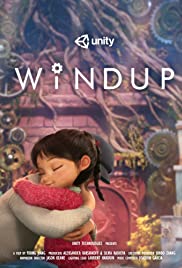A Short Film Explores the Dreamscape of a Child in a Coma
While her faithful father waits and tries to connect with her…Last week, five animated short films competed for Oscar gold, with the top prize going to the emotionally charged “If Anything Happens I Love You.” The short is a bold examination of bereavement as two parents grapple with the violent loss of their young daughter. It’s a worthy winner. However, my own pick didn’t make the shortlist.

WiNDUP (2020), written and directed by young creative Yibing Jiang, is also a poignant meditation on parenthood and grief — in this case, for a child in a possibly irreversible coma — as well as a technical gem. Jiang’s company, Unity, uses custom-built software to create shorts in “real-time 3D” on standard computers.
Doing without certain tools that animators take for granted today, like tessellation shader or animation caches, lends the final product a hand-made look that feels at once fresh and old-fashioned. In her bio, Jiang writes, “We are using techniques from the AAA game production that push the visual bar while rendering 3 million times faster than regular animation films! 3 Million? Yep, you can do the math. 30 frames per second compares with 30 hours per frame.”
Jiang earned an AI degree from a Chinese university, then came to America to chase her artistic dreams. But when COVID hit in 2020, it hit close to home, literally: Wuhan is her hometown. As she raced to finish rendering WiNDUP, she was haunted with fear. For the first time, she understood what it might have been like for her parents to worry over her when she was a sick child—the image that had inspired the film.
The title, “WiNDUP,” is explained in the first shot. A man is crouched in a closet with light filtering in through the slats, holding a small contraption in his hand that we can’t identify, though we see it has a key. As he winds it up, a haunting lullaby begins to play, and we realize it’s a child’s music box. In the next shot, a little girl runs into her bedroom and looks around. We see now that the closet is her closet. She is playing hide-and-seek with her father. He decides to give his location away by humming along, she finds him, and they embrace.
But a fade transition takes us to the present day, transporting us from a little girl’s bedroom to a hospital room. Now she is lying in a coma, and he is pacing restlessly with a photograph in his hand. He pins it up to a bulletin board, along with a collection of other snapshots with just the two of them, together. Then he sits next to her in the visitor’s chair, holding the music box. As she lies quietly, the faintest breath fogging her oxygen mask, he winds it up and puts it to her ear.
That’s when she opens her eyes. But not in this world.
Where do people “go” when they are lying in a coma? At a certain level of unconsciousness, a comatose person’s loved ones are assured that he is aware of their surroundings and should be spoken to naturally, as if he were awake and present. But, as engineer Robert J. Marks and neurosurgeon Michael Egnor discuss in this interview, evidence shows that even people in a “persistent vegetative state” (viewed by some as “vegetables”) can hear and understand us.
Researcher Adrian Owen found that when he put headphones on one such woman and monitored her activity in response to verbal instructions, there were consistent patterns of activation. “Imagine you’re walking across a room,” he would ask her, or “Imagine you’re playing tennis.” “Think of things.” A favorite food. A face. A photograph.
The short film cuts effectively between father and daughter, as she skips through a lush, deserted traditional Chinese dreamscape while he waits in anguish, day after day. Her wonderland is rendered with an uncanny eye for the sorts of elements that recur in all our dreams — a random playground slide, stairsteps, a sudden fall. All the while, the outside world seeps through, suggesting itself in ways that don’t belong. Clusters of moving clock gears show up in odd places. A secret door opens onto a tunnel snaked through with thick power cords. In the distance, faintly, she hears a rhythmic crashing sound. With each crash, a silhouette flashes on the tunnel wall: her father’s bowed head.
Most poignantly, as the story hits its crisis point, both his real world and her dreamworld are touched by the chill of changing seasons. Winter coats the hospital window with a sheet of ice, and at the same time, its frosty fingers reach down to cover the walls and floor of her mysterious tunnel. Her world is growing darker. His teardrops splash onto a picture she has drawn of the two of them. Time, we worry, might be running out.
But, through her own tears, she plucks up the courage to crawl through one last small door. On the other side, she sees something familiar: a beloved stuffed bunny. She cuddles it and explores further, following a slat-filtered light up ahead. On her right, pictures are strung up on a line — her pictures. On her left, she takes a closer look at something: a bulletin board, filled with photographs. They are a little faint, covered by a layer of dust. But they are there.
Now she understands. Now, as the light intensifies, she sees her next move in the game. She has only to run forward. She has only to open the door.
The film’s total runtime comes in at just under ten minutes. It contains not one line of dialogue. But it says more in those ten minutes than an opinion piece ever could.
I have no idea what Yibing Jiang’s religious or political persuasions are. I’m sure she did not intend this piece of art to be a religious or political statement. But then the best kind of art doesn’t set out to make “statements.” The best kind of art simply shows something true, for our consideration.
This Oscar season, it’s unfortunate that the Academy passed her by. But if “WiNDUP” is any indication, I have a feeling she’ll be back.
Note: WiNDUP has received nearly 8 million views since January 21, 2021.
For more on the awareness of persons in a comatose state, you may wish to read:
Does the ability to think depend on consciousness? Neurosurgeon Michael Egnor: From a medical perspective, “consciousness” adds nothing to the description of mental states
and
Can people in comas have abstract thoughts? Neurosurgeon Michael Egnor discusses how we might test for that ability.
